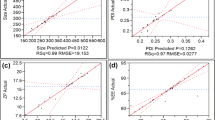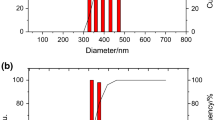Abstract
A nano-sized double-walled carrier composed of chitosan and β-lactoglobulin (β-Lg) for oral administration of epigallocatechin gallate (EGCG) was developed to achieve a prolonged release of EGCG in the gastrointestinal tract. Carboxymethyl chitosan (CMC) solution was added dropwise to chitosan hydrochloride (CHC) containing EGCG to form a primary coating by ionic complexation. Subsequently, β-Lg was added to create a secondary layer by ionic gelation. The obtained EGCG-loaded chitosan/β-Lg nanoparticles had sizes between 100 and 500 nm and zeta potentials ranging from 10 to 35mV. FT-IR spectroscopy revealed a high number of hydrogen-bonding sites in the nanoparticles, which could incorporate EGCG, resulting in high encapsulation efficiency. EGCG incorporated in the primary coating was released slowly over time by diffusion from the swollen CMC-CHC matrix after the outer layer of β-Lg was degraded in the intestinal fluid. The sustained-release property makes chitosan/β-Lg nanoparticles an attractive candidate for effective delivery of EGCG.
Similar content being viewed by others
References
Du GJ, Zhang Z, Wen XD, Yu C, Calway T, Yuan CS, Wang CZ. Epigallocatechin Gallate (EGCG) is the most effective cancer chemopreventive polyphenol in green tea. Nutrition 4: 1679–1691 (2012)
Chaudhury A, Das S. Recent advancement of chitosan-based nanoparticles for oral controlled delivery of insulin and other therapeutic agents. AAPS PharmSciTech 12: 10–20 (2011)
Chen L, Remondetto GE, Subirade M. Food protein-based materials as nutraceutical delivery systems. Trends Food Sci. Tech. 17: 272–283 (2006)
Tang Y, Sun J, Fan H, Zhang X. An improved complex gel of modified gellan gum and carboxymethyl chitosan for chondrocytes encapsulation. Carbohyd. Polym. 88: 46–53 (2012)
Liang J, Li F, Fang Y, Yang W, An X, Zhao L, Xin Z, Cao L, Hu Q. Synthesis, characterization and cytotoxicity studies of chitosan-coated tea polyphenols nanoparticles. Colloid. Surface B 82: 297–301 (2011)
Liang J, Li F, Fang Y, Yang WJ, An XX, Zhao LY, Xin ZH, Hu QH. Response surface methodology in the optimization of tea polyphenols-loaded chitosan nanoclusters formulations. Eur. Food Res. Technol. 231: 917–924 (2010)
Hu B, Pan C, Sun Y, Hou Z, Ye H, Zeng X. Optimization of fabrication parameters to produce chitosan-tripolyphosphate nanoparticles for delivery of tea catechins. J. Agr. Food Chem. 56: 7451–7458 (2008)
Chen LY, Subirade M. Chitosan/b-lactoglobulin core-shell nanoparticles as nutraceutical carriers. Biomaterials 26: 6041–6053 (2005)
Teng Z, Luo Y, Wang Q. Carboxymethyl chitosan-soy protein complex nanoparticles for the encapsulation and controlled release of vitamin D3. Food Chem. 141: 524–532 (2013)
Hu B, Ting Y, Zeng X, Huang Q. Cellular uptake and cytotoxicity of chitosan–caseinophosphopeptides nanocomplexes loaded with epigallocatechin gallate. Carbohyd. Polym. 89: 362–370 (2012)
Peram MR, Loveday SM, Ye A, Singh H. In vitro gastric digestion of heatinduced aggregates of b-lactoglobulin. J. Dairy Sci. 96: 63–74 (2013)
Lee PS, Yim SG, Choi Y, Thi VAH, Ko S. Physiochemical properties and prolonged release behaviours of chitosan-denatured beta-lactoglobulin microcapsules for potential food applications. Food Chem. 134: 992–998 (2012)
Ha HK, Kim JW, Lee MR, Lee WJ. Formation and characterization of quercetinloaded chitosan oligosaccharide/β-lactoglobulin nanoparticle. Food Res. Int. 52: 82–90 (2013)
Hu B, Ting YW, Zeng XX, Huang QR. Bioactive peptides/chitosan nanoparticles enhance cellular antioxidant activity of (-)-Epigallocatechin-3-gallate. J. Agr. Food Chem. 61: 875–881 (2013)
Yang CS, Lambert JD, Sang S. Antioxidative and anti-carcinogenic activities of tea polyphenols. Arch. Toxicol. 83: 11–21 (2009)
Mounsey JS, O’Kennedy BT, Fenelon MA, Brodkorb A. The effect of heating on beta-lactoglobulin-chitosan mixtures as influenced by pH and ionic strength. Food Hydrocolloid. 22: 65–73 (2008)
Cho Y, Kim JT, Park HJ. Size-controlled self-aggregated N-acyl chitosan nanoparticles as a vitamin C carrier. Carbohyd. Polym. 88: 1087–1092 (2012)
Xing JF, Deng LD, Li J, Dong AJ. Amphiphilic poly{[alpha-maleic anhydrideomega-methoxy-poly(ethylene glycol)]-co-(ethyl cyanoacrylate)} graft copolymer nanoparticles as carriers for transdermal drug delivery. Int. J. Nanomedicine 4: 227–232 (2009)
Vino AB, Ramasamy P, Shanmugam V, Shanmugam A. Extraction, characterization and in vitro antioxidative potential of chitosan and sulfated chitosan from Cuttlebone of Sepia aculeata Orbigny, 1848. Asian Pac. J. Trop. Biomed. 2: S334–S341 (2012)
Gazori T, Khoshayand MR, Azizi E, Yazdizade P, Nomani A, Haririan I. Evaluation of Alginate/Chitosan nanoparticles as antisense delivery vector: Formulation, optimization and in vitro characterization. Carbohyd. Polym. 77: 599–606 (2009)
Shpigelman A, Cohen Y, Livney YD. Thermally-induced beta-lactoglobulin-EGCG nanovehicles: Loading, stability, sensory and digestive-release study. Food Hydrocolloid. 29: 57–67 (2012)
Chanasattru W, Jones OG, Decker EA, McClements DJ. Impact of cosolvents on formation and properties of biopolymer nanoparticles formed by heat treatment of beta-lactoglobulin-pectin complexes. Food Hydrocolloid. 23: 2450–2457 (2009)
Woo HD, Moon TW, Gunasekaran S, Ko S. Determining the gelation temperature of â-lactoglobulin using in situ microscopic imaging. J. Dairy Sci. 96: 5565–5574 (2013)
Li B, Du WK, Jin JC, Du QZ. Preservation of (-)-Epigallocatechin-3-gallate antioxidant properties loaded in heat treated b-lactoglobulin nanoparticles. J. Agr. Food Chem. 60: 3477–3484 (2012)
Olsen K, Otte J, Skibsted LH. Steady-state kinetics and thermodynamics of the hydrolysis of beta-lactoglobulin by trypsin. J. Agr. Food Chem. 48: 3086–3089 (2000)
Author information
Authors and Affiliations
Corresponding author
Rights and permissions
About this article
Cite this article
Liang, J., Yan, H., Yang, HJ. et al. Synthesis and controlled-release properties of chitosan/β-Lactoglobulin nanoparticles as carriers for oral administration of epigallocatechin gallate. Food Sci Biotechnol 25, 1583–1590 (2016). https://doi.org/10.1007/s10068-016-0244-y
Received:
Revised:
Accepted:
Published:
Issue Date:
DOI: https://doi.org/10.1007/s10068-016-0244-y




